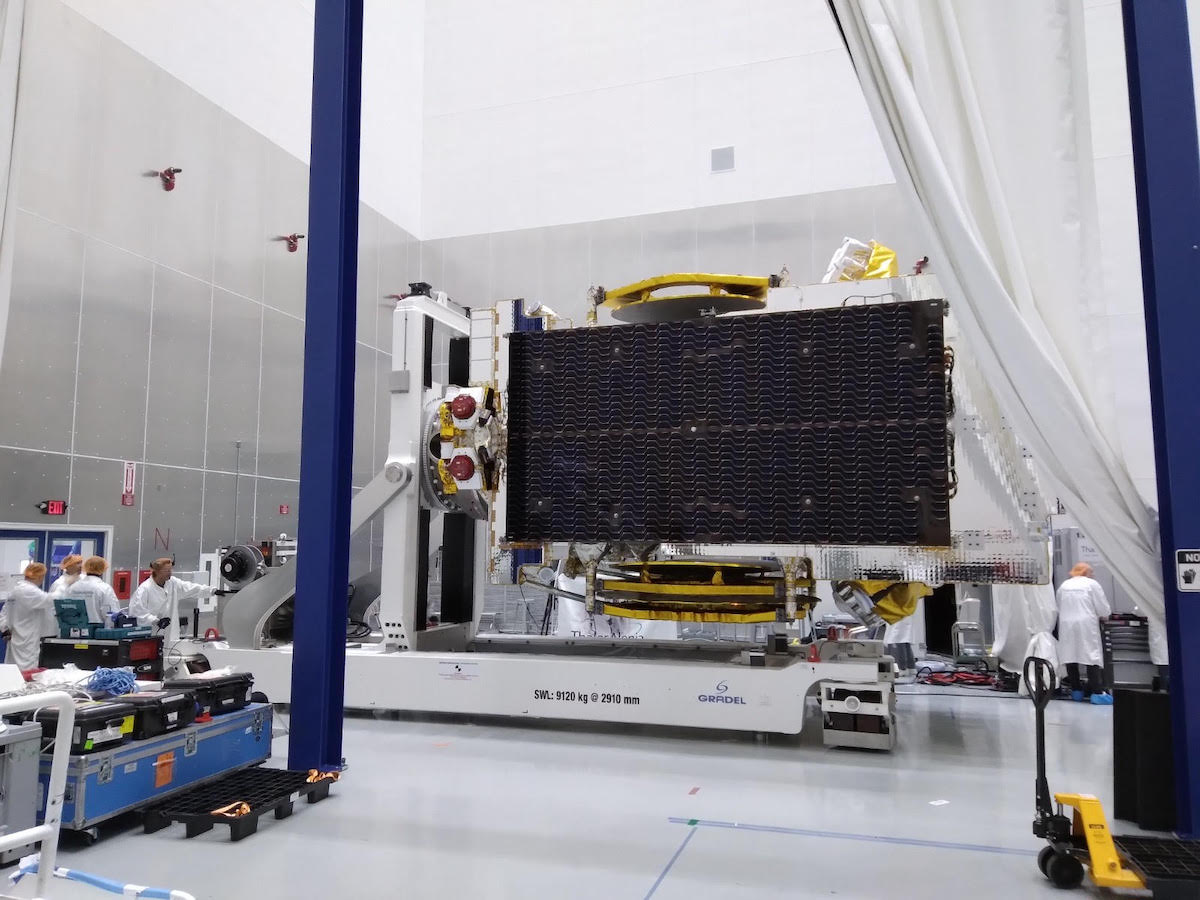February's Full Snow Moon rises on Sunday (Feb. 5) and will be the smallest full moon of the year due to the current position of the moon in its orbit.
Space News & Blog Articles
How astronaut diversity changed for the better in a single NASA class
Thirty-five new astronauts joined the corps in 1978, among them women and people of color who reshaped the agency forever, a new book shows.
US military shoots down Chinese surveillance balloon
An F-22 fighter jet destroyed a Chinese balloon with a Sidewinder missile on Saturday (Feb. 4) when the airship was over the Atlantic Ocean off the South Carolina coast.
Watch SpaceX launch big communications satellite on Sunday
SpaceX plans to launch Hispasat's Amazonas Nexus communications satellite to orbit Sunday (Feb. 5), and you can watch the action live.
Release of 'Star Wars Jedi: Survivor' video game delayed to April 28
"Star Wars Jedi: Survivor's" design team announced a six-week delay for the game's release, to April 28.
Astronomers use Earthquakes to Understand Glitches on Neutron Stars
A team of astronomers have used a model of earthquakes to understand glitches in the timing of pulsars. Their results suggest that pulsars may have interiors that are far stranger than can be imagined.
Pulsars are perhaps the most accurate timekeepers in the entire universe. The pulsars themselves are really rapidly spinning neutron stars. Neutron stars are ultra-dense balls of atomic matter, usually no bigger than a few miles across with a mass a few times that of the Sun.
When these neutron stars spin they blast out beams of radiation that draw circles around the sky. If the Earth happens to lie on one of those circles then we see a periodic flashing from those beams of radiation, creating a pulsar.
Pulsars will keep accurate rhythm for incredibly long periods of time. But occasionally they are known to glitch, when they suddenly shift from one rotation rate to another.
Astronomers do not fully understand what causes the glitches, but recently a team of researchers put together a model of how glitches operate. The model is based on earthquakes. Earthquakes have many causes, but one of them is when too much tension and pressure builds up between tectonic plates and the crust of the Earth buckles under the pressure. That results in an earthquake and a resettling of the material in the Earth.
Tonga's massive volcanic eruption wiped out unique, never-before-seen life-forms
The island was destroyed by the same volcano that formed it seven years before.
Spanish-owned communications satellite ready for weekend launch
Artist’s concept of the Amazonas Nexus satellite in orbit, with its antennas and solar arrays unfurled. Credit: Thales Alenia Space
A nearly five-ton satellite for the Spanish company Hispasat is ready for liftoff from Cape Canaveral Sunday, weather permitting, aboard a SpaceX Falcon 9 rocket, beginning a mission to provide in-flight internet and other communications services over the Americas and the Atlantic Ocean.
Hispasat’s Amazonas Nexus satellite, built in France by Thales Alenia Space, is scheduled for launch during a four-hour window opening at 5:32 p.m. EST (2132 GMT) Sunday from Cape Canaveral Space Force Station in Florida. SpaceX will deploy the satellite into an elongated “super synchronous” transfer orbit stretching more than 30,000 miles (50,000 kilometers) above Earth.
The weather forecast is iffy, with just a 30% chance of favorable weather at Cape Canaveral at the opening of the launch window Sunday. Conditions are forecast to improve later in the evening, with a 55% chance of acceptable weather at the end of the launch window.
SpaceX will also monitor wind and sea conditions a few hundred miles east of Cape Canaveral, where the Falcon 9 booster is set to land on a drone ship in the Atlantic Ocean. There’s a high risk of out-of-limits weather conditions for landing there Sunday.
Forecasters expect weather conditions to dramatically improve for a backup launch opportunity Monday evening.


Watch the green comet pass the bright star Capella on Sunday (Feb. 5)
It's a meeting of the GOATs this weekend when superstar green comet C/2022 E3 meets up with Capella, the Goat Star. Capella should help skywatchers spot C/2022 E3 as it races away from Earth.
Space Foundation to award US Postal Service for 75 years of space stamps
The Space Foundation is recognizing the United States Postal Service (USPS) and its 75 years of space-themed postage with the Douglas S. Morrow Public Outreach Award.
Hubble Space Telescope captures chaotic globular cluster near Milky Way's core
A Hubble Space Telescope image shows the scattered and chaotic population of stars in a globular cluster located 31,000 light-years from Earth.
The James Webb May See the First Stars to Appear in the Universe
Astronomers continue to hunt for the elusive kind of star known as Population III stars, the first stars to appear in the young universe. New research has revealed that the James Webb Space Telescope may be on the cusp of discovering them.
The stars that exist in the universe today are nothing like the first generation of stars to appear in the cosmos. With every generation of stars that lives and dies, more metals, which in astronomy are any element heavier than hydrogen and helium, add to the mix. The presence of these metals fundamentally changes the characteristics of the next generation of stars.
In contrast, the first generation of stars formed from an almost pristine mixture of pure hydrogen and helium using mechanisms that we do not yet fully understand. Members of the first generation of stars to appear in that primordial soup are known as Population III (or Pop III) stars, while intermediate stars are called Pop II stars, and then the latest generation of stars are called Pop I. Astronomers have searched for decades for any remnant populations of Pop III stars in the modern-day universe to no avail.
That means that they have to go back to earlier times to catch a glimpse of a Pop III star. But observations of the early epochs of the history of the universe are extremely difficult, and it’s unclear if our searches will be successful. Recently a team of astrophysicists conducted computer simulations of the formation of the first stars in the universe. They specifically looked to see if how long Pop III stars could continue forming in the young universe.
They found that Pop III stars could still appear in relatively mature galaxies. The galaxies had to have reservoirs of pure hydrogen and helium still remaining. If the conditions were just right, Pop III stars could still form in those pockets. Even though those stars wouldn’t technically be amongst the first generation of stars to appear in the universe, they would still have many of the same properties.
Curiosity Finds Another Metal Meteorite on Mars
MSL Curiosity is going about its business exploring Mars. The high-tech rover is currently exploring the sulphate-bearing unit on Mt. Sharp, the central peak in Mars’ Gale Crater. Serendipity placed a metal meteorite in its path.
The meteorite is made mostly of nickel and iron, and it has a name: Cacao. (Chocolate comes from cacao.) Cacao isn’t very large; it’s only about 30 cm (1 ft.) across. Curiosity has come across several meteorites since landing in Gale Crater in August 2012.
Cacao stands out visually from its surroundings. While the Martian surface is red from oxides, the meteorite is dark grey and metallic-looking. It’s also smooth and rounded, obvious signs that it passed through an atmosphere.
The image is a composite of six individual images taken with the rover’s Mastcam. Curiosity captured the images on Jan 27, 2023, the 3,724th Martian day, or sol, of the mission. The colours in the image have been corrected to match the lighting conditions as seen with human eyes on Earth.
A high-resolution TIFF is available at https://photojournal.jpl.nasa.gov/catalog/PIA25737 Credit: NASA/JPL-Caltech/MSSSThe grooves and pits are called regmaglypts. They’re particularly interesting on iron meteorites. They formed when Cacao was travelling through the atmosphere. Even though Mars’ atmosphere is much thinner than Earth’s, it still creates enough friction to heat the meteorite’s surface. The regmaglypts are likely created by vortices of hot gas that melted the rock as it travelled through the atmosphere.




SpaceX's 200th Falcon 9 rocket launch looks absolutely gorgeous in these photos
SpaceX's Falcon 9 rocket notched its 200th successful orbital mission on Thursday (Feb. 2), and the company marked the milestone by sharing some stunning photos of the spaceflight action.
Private Peregrine moon lander will now touch down near 'geologic enigma'
NASA has redirected the private Peregrine moon lander to a new touchdown site to increase science returns ahead of crewed Artemis missions.
Terence Dickinson (1943 – 2023)
Terence Dickinson, Canadian astronomer and author of numerous popular books on astronomy, has passed away.
The post Terence Dickinson (1943 – 2023) appeared first on Sky & Telescope.
Hungry Black Hole was Already Feasting 800 Million Years After the Big Bang
Black holes swallow everything—including light—which explains why we can’t see them. But we can observe their immediate surroundings and learn about them. And when they’re on a feeding binge, their surroundings become even more luminous and observable.
This increased luminosity allowed astronomers to find a black hole that was feasting on material only 800 million years after the Universe began.
Even with everything astrophysicists have learned, black holes are still mysterious. We know that the largest ones—supermassive black holes (SMBH)—reside in the centers of galaxies like the Milky Way. But the history of their formation, growth, and evolution is still shrouded in cosmic mystery.
Astrophysicists can infer the presence of these monsters in the heart of galaxies by the effect their massive gravitational pull has on nearby stars. But a better opportunity to study them is when they’re actively feeding. An actively feeding black hole is called an active galactic nucleus (AGN,) and when an AGN is extremely luminous, it’s called a quasar. As material swirls around their accretion disks, it heats up and emits x-rays.
Scientists have struggled to locate quasars in the early Universe, but it’s an important goal in black hole research. They need to find them in order to trace their development over time. One stumbling block in their efforts is the time period correlating with redshifts greater than z=6, about 12.716 billion years ago, or about one billion years after the Big Bang.



'Vibration disturbance' caused failure of new Indian rocket, ISRO says
Indian space officials say they know what went wrong on the debut flight of the nation's new rocket last summer.
Move over, Saturn: Jupiter is the solar system's new 'moon master'
Jupiter now boasts the largest number of moons orbiting it after scientists discovered another 12 moons, bringing the behemoth's total up to 92.
Watch February's Full Snow Moon on Sunday (Feb. 5) with this free telescope webcast
February's Full Snow Moon rises on Sunday (Feb. 5), and you can watch it shine brightly in the sky from the comfort and warmth of your own home thanks to a free telescope webcast.

